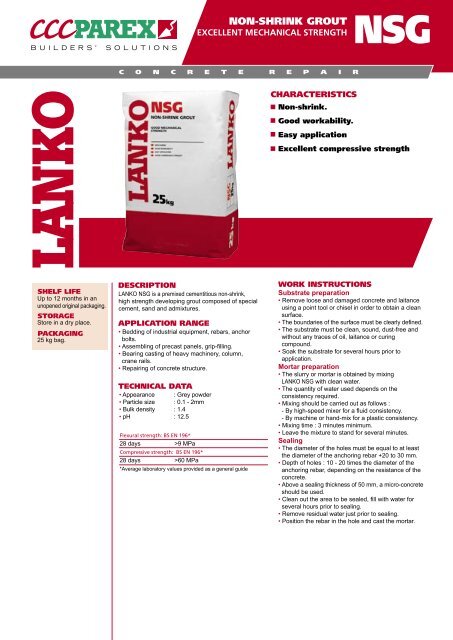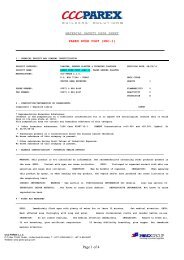Create successful ePaper yourself
Turn your PDF publications into a flip-book with our unique Google optimized e-Paper software.
NON-SHRINK GROUT<br />
EXCELLENT MECHANICAL STRENGTH<br />
NSG<br />
C O N C R E T E R E P A I R<br />
CHARACTERISTICS<br />
Non-shrink.<br />
Good workability.<br />
Easy application<br />
Excellent compressive strength<br />
SHELF LIFE<br />
Up to 12 months in an<br />
unopened original packaging.<br />
STORAGE<br />
Store in a dry place.<br />
PACKAGING<br />
25 kg bag.<br />
DESCRIPTION<br />
LANKO NSG is a premixed cementitious non-shrink,<br />
high strength developing grout composed of special<br />
cement, sand and admixtures.<br />
APPLICATION RANGE<br />
• Bedding of industrial equipment, rebars, anchor<br />
bolts.<br />
• Assembling of precast panels, grip-filling.<br />
• Bearing casting of heavy machinery, column,<br />
crane rails.<br />
• Repairing of concrete structure.<br />
TECHNICAL DATA<br />
• Appearance : Grey powder<br />
• Particle size : 0.1 - 2mm<br />
• Bulk density : 1.4<br />
• pH : 12.5<br />
Flexural strength: BS EN 196*<br />
28 days >9 MPa<br />
Compressive strength: BS EN 196*<br />
28 days >60 MPa<br />
*Average laboratory values provided as a general guide<br />
WORK INSTRUCTIONS<br />
Substrate preparation<br />
• Remove loose and damaged concrete and laitance<br />
using a point tool or chisel in order to obtain a clean<br />
surface.<br />
• The boundaries of the surface must be clearly defined.<br />
• The substrate must be clean, sound, dust-free and<br />
without any traces of oil, laitance or curing<br />
compound.<br />
• Soak the substrate for several hours prior to<br />
application.<br />
Mortar preparation<br />
• The slurry or mortar is obtained by mixing<br />
LANKO NSG with clean water.<br />
• The quantity of water used depends on the<br />
consistency required.<br />
• Mixing should be carried out as follows :<br />
- By high-speed mixer for a fluid consistency.<br />
- By machine or hand-mix for a plastic consistency.<br />
• Mixing time : 3 minutes minimum.<br />
• Leave the mixture to stand for several minutes.<br />
Sealing<br />
• The diameter of the holes must be equal to at least<br />
the diameter of the anchoring rebar +20 to 30 mm.<br />
• Depth of holes : 10 - 20 times the diameter of the<br />
anchoring rebar, depending on the resistance of the<br />
concrete.<br />
• Above a sealing thickness of 50 mm, a micro-concrete<br />
should be used.<br />
• Clean out the area to be sealed, fill with water for<br />
several hours prior to sealing.<br />
• Remove residual water just prior to sealing.<br />
• Position the rebar in the hole and cast the mortar.
NSG<br />
EXCELLENT<br />
NON-SHRINK GROUT<br />
MECHANICAL STRENGTH<br />
C O N C R E T E R E P A I R<br />
Grouting<br />
• Formworks shall be sufficiently tight-fitting and<br />
sealed against leakages.<br />
• On the placement side, the forms should be<br />
constructed above the bottom of the plate to<br />
form a headbox. The headbox should be<br />
positioned at a minimum of 50 mm from the<br />
plate and slope away at a 45° angle to assist<br />
grout placement as well as prevent air entrapment.<br />
• The form should be minimum 50 mm away from the<br />
plate and extend at least 25 mm above the bottom<br />
of the plate.<br />
• Non-absorbent formwork is preferred, otherwise, it<br />
should be properly oiled to prevent grout adhesion.<br />
• Thoroughly wet all surfaces prior placement and<br />
remove any excess water just before introducing<br />
the grout.<br />
• The mixed grout should be placed promptly before<br />
it stiffens. Higher temperature will accelerate setting<br />
time.<br />
• Pour grout from one side only to avoid air<br />
entrapment.<br />
• Adequate grout head must be maintained at all time<br />
to achieve a continuous flow.<br />
• Use a rod or strap to assist in large/difficult<br />
placement as well as to facilitate maximum surface<br />
contact. Vibrator should not be used. Excessive<br />
vibration will cause separation of each ingredient.<br />
Curing<br />
• As soon as the mortar begins to set, the exposed<br />
surface should be cured for about 3 days.<br />
PRECAUTIONS<br />
• Temperature range for use : +5°C to +45°C<br />
• Apply only to clean, sound, resistant substrates,<br />
free of loose material.<br />
• Substrate must be soaked for several hours prior<br />
to application.<br />
• Residual water must be removed prior to<br />
application.<br />
• Do not mix with other hydraulic binders.<br />
• Sand and admixtures must not be added.<br />
• Foresee the need for intermediate joints and<br />
respect the existing structural jonts.<br />
Dosage / Yield<br />
LANKO NSG<br />
Water<br />
Workable mortar<br />
1 bag 25 kg<br />
3 - 3.5 litres<br />
12 litres<br />
“The information provided in this document results from our knowledge of the product and our experience. On-site results may vary, in particular according to the product application<br />
methods adopted. Where application methods not covered by this document are used, customers must request additional information and /or carry out a representative test before using<br />
the products. The above- mentioned information in no way constitutes a warranty relative to the use of the products. Our general terms and conditions of sale shall prevail, in any event, on<br />
the information provided in this document. Prior to application, customers and users are requested to check that they have the latest version of this document”<br />
Technical Documentation English-Version August 2006<br />
CCC-PAREX (L.L.C.)<br />
PO Box 71544 Dubai, United Arab Emirates<br />
T: +971 4 884 23 00 F: +971 4 884 23 01 www.parex-group.com








